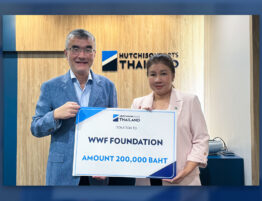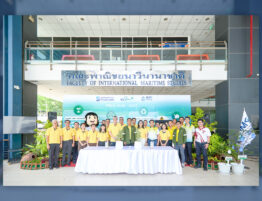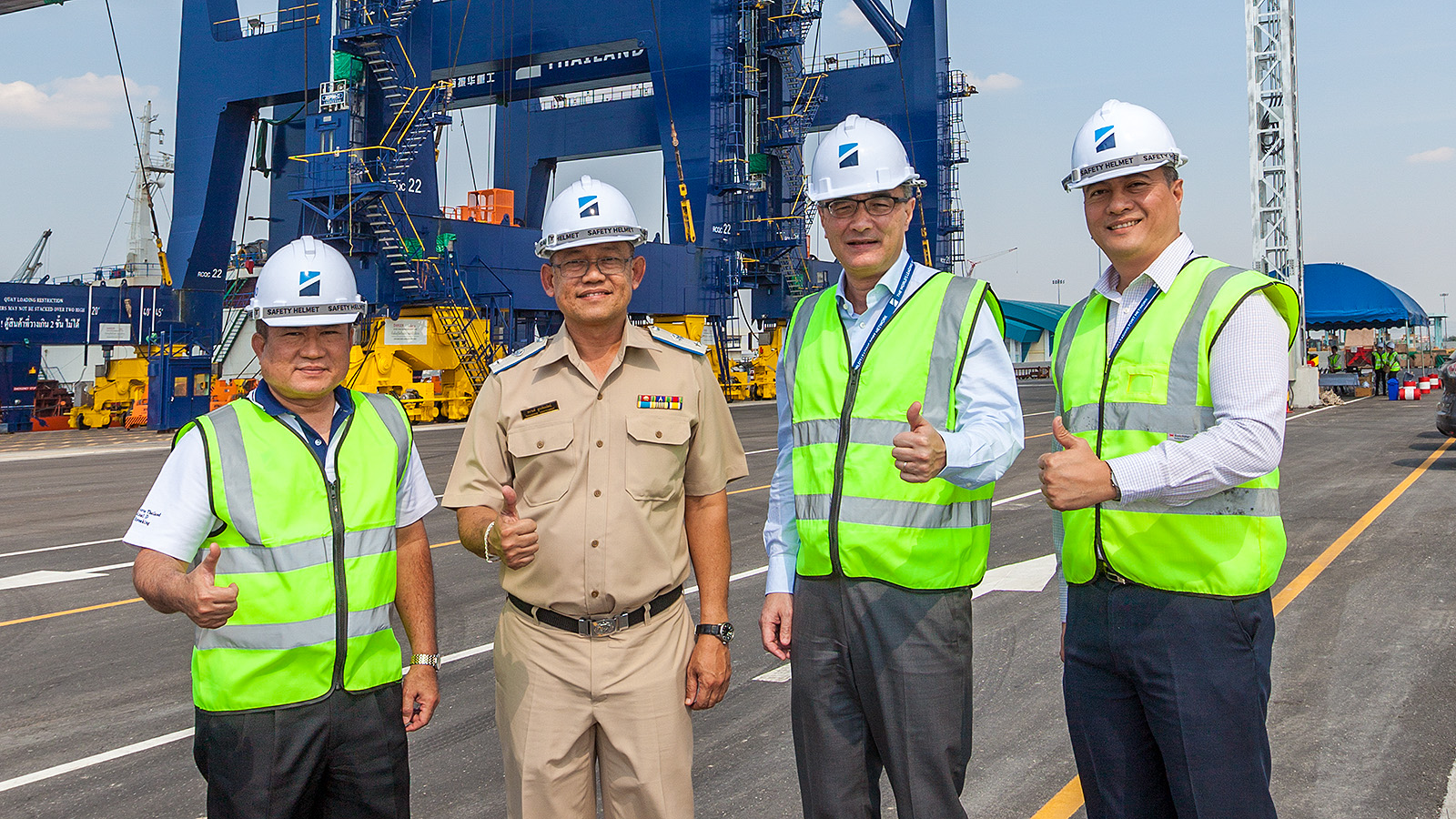
What does it take to become a leader? Often it encompasses having many quality traits, such as intelligence, toughness, determination, and vision. Having the understanding that not following the pack and leading by example is the embodiment of excellent leadership and guidance.
As the largest terminal operator in Thailand, Hutchison Ports Thailand (HPT), is leading from the forefront with the introduction of new ground-breaking, never before seen technology at Laem Chabang Port. Proving their prowess, they are investing into Terminal D, a new purpose-built terminal that when completed will be able to handle some of the largest mega vessels currently in operation.
While construction is still underway, key parts to the terminal were recently delivered. This included three quay cranes and eight electric rubber tyred gantry cranes delivered by one of the world’s crane manufacturers, Shanghai Zhenhua Heavy Industry Co., Ltd. (ZPMC) in Shanghai. The new equipment most notably features remote control capabilities, a first for any container terminal in Thailand.
The new terminal embodies much of what HPT has been steadily looking to accomplish over the past few decades at Laem Chabang Port; increasing their presence, and in turn the sustainability of the Port itself. The investment into Terminal D is the collective manifestation of their work and looks to become a beacon for other terminals around the region to emulate. For more information about their developments into Terminal D and about the new equipment that was just delivered, we spoke further with Mr. Stephen Ashworth, Managing Director – Thailand & South East Asia at Hutchison Ports.
Innovative Equipment
Among the equipment recently delivered by ZPMC, the three remote control quay cranes (RC QC) have an outreach of 24 rows, a height above rail of 53 meters, and a lifting capacity of 61 metric tons. These RC QCs are among the largest container quay cranes in the world and will be by far the largest cranes operating in Thailand. The remote control electric rubber tyred gantry cranes (RC eRTGC) are capable of stacking 1 over 6 containers in the yard, and have a lifting capacity 40 metric tons. The RC eRTGCs are the first RTGCs of their type to be delivered to a Hutchison Ports container terminal globally – a significant milestone for Thailand and the Hutchison Ports group.
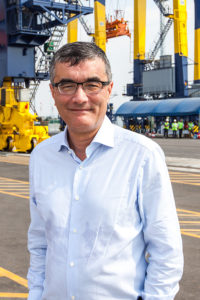
The investment in remote control technology that HPT is providing with this new terminal equipment will enable Terminal D to operate safely and more accurately, and in turn, allows the terminal to achieve even higher levels of vessel and yard productivity than is possible under a conventional operation.
Mr. Ashworth said: “Specifically, we’re looking at centralizing the operators of the gantry cranes in an operations centre with screens, consoles, and the operator is essentially monitoring the automatic lifting of containers on and off the vessels and within the yard. What we’re also trying to do is learn from our sister terminals in the Group that are already using this technology. We’ll be able to send staff to these terminals to train and learn so when the first phase of Terminal D comes online, we should have a lot of knowledge already in place. Once completed, Terminal D will be the group’s flagship gateway terminal for the South East Asia region, and it will be used as a platform for training our own operators on remote control operations and also bringing our people to Thailand from all over the world to train here.”
Mr. Ashworth continued: “The plan with Terminal D is to make it so the largest of vessels can come to Laem Chabang Port. These larger vessels may take some time before they cascade to Thailand, but we are still thinking ahead of the curve. We are investing in cranes at Terminal D that are a bit larger for vessels to grow into. Besides larger equipment, we are also investing in remote control technology for Terminal D. While this technology is brand new for Thailand, many terminals have moved, or are moving to this type of operation. Not too long from now, it will most likely be unusual to see a major container terminal running under a conventional mode. It’s also certainly more appealing to staff at the terminal as well; at the core of it, our crane operators can work in a much more comfortable environment and it also helps to keep productivity high”
The new equipment is just one part of HPT’s overall strategy for expansion in Thailand. HPT already operates Terminals A2, A3, C1, and C2 at Laem Chabang Port, which are currently operating at close to capacity. The additional capacity at Terminal D will enable HPT to meet the anticipated growth in demand of the market going forward. The new terminal will bring HPT’s total capacity to in excess of 6 million TEUs, cementing their place as the largest terminal operator in Thailand.
When the Terminal D facility is completed, it will become an integral part of the government’s infrastructure plans for the Eastern Economic Corridor Development Project (EEC). The announced plans to start the EEC Development Project is expected to drive further growth in the future which means that this is the ideal time for Hutchison Ports Thailand to be in the midst of constructing Terminal D.
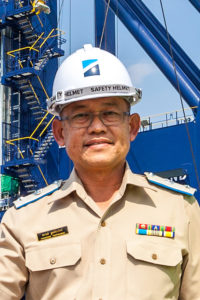
“The initial Phase 1A of Terminal D will be comprised of 400 metres of deep water berth, 3 super post-panamax quay cranes and 10 supporting yard cranes, and should be operational by around the middle of 2018,” said Mr. Ashworth. “By the middle of 2019, the remaining Phase 1B of this first phase of Terminal D will be completed delivering a combined total of 1,000 metres of berth, 6 quay cranes and 20 supporting yard cranes. We’re designing this as a premium terminal for our customers who are looking to deploy larger vessels to Laem Chabang Port and to benefit from shorter vessel turnaround times in order to stay competitive and realize cost savings. Our niche market is going to be for larger long-haul vessels operating shipping routes to say, North America and Europe. However, while we’re designing the terminal with larger vessels in mind, it doesn’t mean that we won’t accommodate smaller feeder and intra-Asia type vessels there. The terminal will be available to any of our customers. We’re flexible already with the terminal space we have at Laem Chabang, but this opens up and gives us even more flexibility.”
Beyond the opening of Terminal D, Mr. Ashworth sees Thailand as being a major South East Asian gateway terminal for their Group in the next 5 to 10 years. “Terminal D will be one of the largest remote control operated terminals in the world. This level of investment in infrastructure, equipment and technology reflects both the Hutchison Ports Group’s commitment to Thailand and Laem Chabang Port and its desire to transform Hutchison Ports Thailand into one of the Group’s flagship terminals. We are in this for the long term and we’ll continue to invest in a future for us and our customers here in Thailand.”
In a statement, Police. Lt. Thanabodee Toopteanrat, Director of Operations Bureau of LCP, said: “HPT’s investment into terminal equipment with remote control technology will enable Terminal D to operate with a high degree of accuracy and safety. Upon Terminal D’s completion, the Port will also be able to service the largest container vessels currently in operation. In addition, Terminal D and the flexible technology it brings, will enable HPT to increase the capacity of import-export cargo through the Port. All of this will play an important role in supporting the economy of the country and the government’s infrastructure plans for the Eastern Economic Corridor Development Project (EEC). It will also help Laem Chabang Port to achieve its vision of becoming a multimodal transport and logistics hub for ASEAN.”






